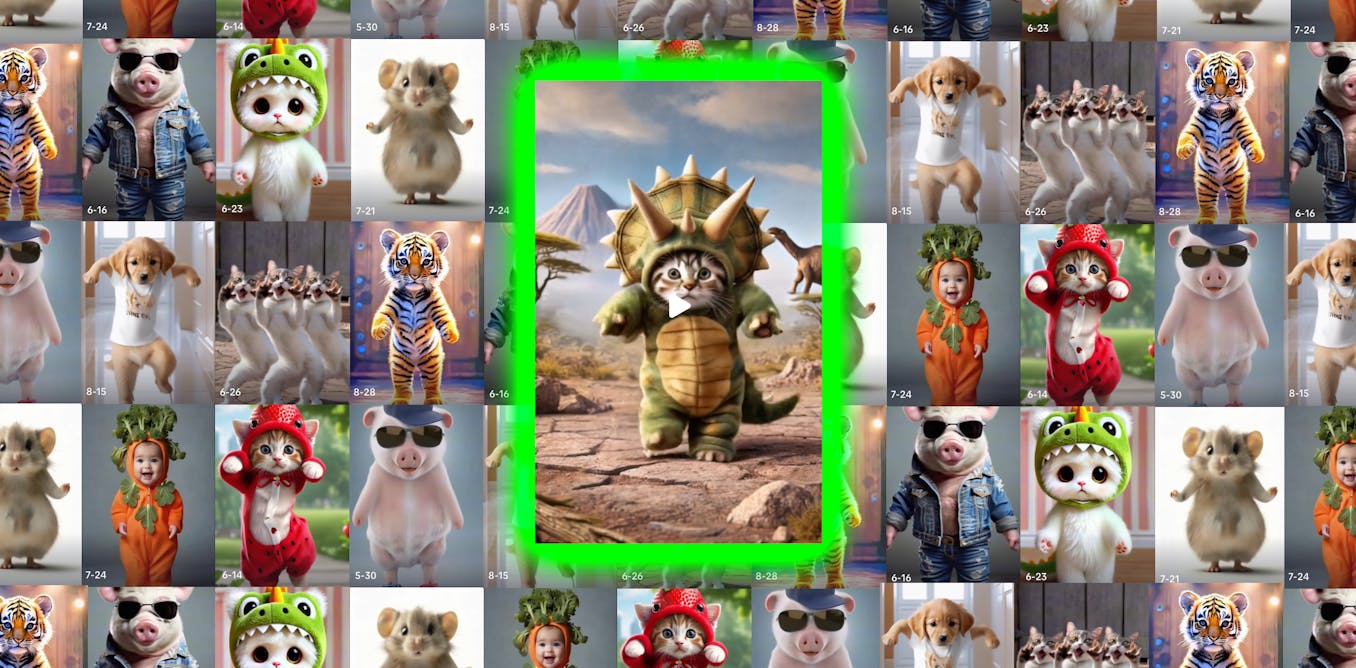TikTok, Facebook and other social media platforms are being flooded with uncanny and bizarre content generated with artificial intelligence (AI), from fake videos of the US government capturing vampires to images of shrimp Jesus.
Given its outlandish nature and tenuous relationship with reality, you might think this so-called “AI slop” would quickly disappear. However, it shows no sign of abating.
In fact, our research suggests this kind of low-quality AI-generated content is becoming a lucrative venture for the people who make it, the platforms that host it, and even a growing industry of middlemen teaching others how to get in on the AI gold rush.
When generative AI meets profiteers and platforms
The short explanation for the prevalence of these baffling videos and images is that savvy creators on social media platforms have worked out how to use generative AI tools to earn a quick buck.
But the full story is more complex. Platforms have created incentive programs for content that goes viral, and a whole ecosystem of content creators has arisen using generative AI to exploit these programs.
Much of the conversation around generative AI tools focuses on how they enable ordinary people to “create”. Many earlier digital technologies have also made it easier to participate in creative activities, such as how smartphones made photography ubiquitous.
But generative AI takes this a step further, as it can generate tailored images or videos from a simple text prompt. It makes content creation more accessible – and also opens the floodgates to mass production on social media.
To take just one example: if you search “pet dance motorcycle” on TikTok, you will find hundreds of AI-generated videos of animals doing the “motorbike dance”, all animated using the same AI template. Some accounts post dozens of videos like this every day.
Creators and platforms are making money
You may wonder why such repetitive, unimaginative content can go viral on TikTok. The answer lies in the platform’s own advice to aspiring creators: if you want your videos to be promoted, you should “continuously share fresh and diverse content” that “doesn’t require a big production budget”.
You may also wonder why some platforms don’t ban AI accounts for polluting the platform’s content stream. Other platforms such as Spotify and YouTube, which police intellectual property rights more aggressively than TikTok, invest considerable resources to identify and remove AI-generated content.
TikTok’s community guidelines do ban “inaccurate, misleading, or false content that may cause significant harm”, but AI-generated content – at least for now – does not qualify as causing “significant harm”.
Instead, this kind of content has become important for platforms. Many of those “pet dance motorcycle” videos, for example, have been viewed tens of millions of times. As long as users are scrolling through videos, they are getting exposed to the ads that are the platforms’ primary source of income.
Inside the AI ‘gold rush’
There is also a growing industry of people teaching others how to make money using cheap AI content.
Take Xiaonan, a social media entrepreneur we interviewed who runs six different TikTok accounts, each with more than 100,000 followers. As he revealed in a live-streaming tutorial with more than 1,000 viewers, Xiaonan earned more than US$5,500 from TikTok in July alone.
Xiaonan also hosts an exclusive chatting group where, for a fee, he reveals his most effective AI prompts, video headlines and hashtags tailored for different platforms including YouTube and Instagram. Xiaonan also reveals tricks for standing out in the platforms’ recommendation game and avoiding platform regulations.
Xiaonan says he established his “AI side job” after being laid off by an internet company. He now works with two partners selling classes and tutorials on making AI-generated videos and other types of spam for profit.
Creators posting AI content may not be the kind of people we expect. As Xiaonan told us, many of the people taking his AI tutorial – entitled “Side job, self-employed, high-paid” – are housewives, unemployed people and college students.
“Some of us also do Uber driving or street vending,” one creator told us. AI-generated content has become the latest trend for earning side income.
The rise of AI has coincided with global unemployment trends and the growth of the gig economy in the post-pandemic era.
Making AI-generated content is more pleasant work than driving passengers or delivering food, according to a creator who is also a stay-at-home mother. It’s easy to learn, almost zero cost, and can be done any time at home with just a phone.
As Xiaonan says, his method is to use AI to “earn from productivity gap” – that is, by producing far more content than people who don’t use AI .
The global AI-generated content factory
Our observations indicate many of these creators are from non-Western countries, such as India, Vietnam and China.
As one Chinese social media influencer told us:
China’s short video market is nearing saturation, which means you need to seek data traffic [viewers] on overseas platforms.
For these entrepreneurs, AI is the secret sauce not only for creating viral content but also for circulating already-viral videos across different countries and platforms.
An effective strategy mentioned by one creator is a kind of platform arbitrage involving popular videos from Douyin, the counterpart of TikTok in mainland China.
A creator will take one of these videos, add AI-generated translation, and post the result on TikTok. Despite clunky AI dubbing and error-riddled subtitles, many of these videos garner hundreds of thousands or even millions of views.
Creators often mute the original video and add AI-generated narration, translating the content into various languages, including French, Spanish, Portuguese, Indonesian and Swedish. These creators often manage several or even dozens of accounts, targeting viewers in different countries in a strategy known as an “account matrix”.
This is only the beginning
We are only at the dawn of mainstream AI-generated content culture. We will soon face a situation in which content is effectively infinite, but human attention is still limited.
For platforms, the challenge will be balancing the engagement these AI-driven trends bring with the need to maintain trust and authenticity.
Social media platforms will soon respond. But before that, AI-generated content will continue to grow wildly – at least for a while.

The post “behind the AI slop flooding TikTok and Facebook” by Jiaru Tang, PhD student, Digital Media Research Centre, Queensland University of Technology was published on 09/19/2024 by theconversation.com




































Leave a Reply